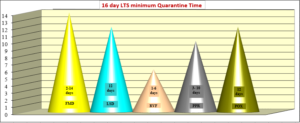Livestock Export Risk Management
We move livestock and leave the disease behind.
Diseases of trade can create havoc for importing countries and seriously tarnish the names of exporting countries. Risks are many and substantial. Diseases can place the consumers, livestock populations, or both in importing countries at risk.
The diseases that we monitor for and when necessary prevent through vaccination include;
- Foot and Mouth Disease
- Sheep and goat pox
- Lumpy skin disease
- Hemorrhagic septicemia
- Rift Valley Fever
- Brucellosis
- Malignant Catarrhal Fever
- Tuberculosis
- Heartwater
- Peste des Petits Ruminants
- Contagious Bovine and Caprine Pleuropneumonia
Additionally, some importing countries desire that we monitor for other diseases which are then included in the list for that country.
Live Animal Quarantine Period
The incubation period—period during which an animal may be developing the disease, but not show clinical signs is the guide for establishing quarantine period. For the above and other diseases, the maximum incubation period is 14 days. Building in a safety factor, the LTS minimum quarantine time is 16 days as can be seen below. However, importing countries sent the required quarantine days using a combination of OIE standards and other relevant factors.
LTS always adheres to the quarantine time established by the importing country. We make no exceptions.
Safe Meat & Livestock for All
Meat, carry special risks which are different from livestock since they are directly consumed and once inspected is passed at import the meat is considered safe for human consumption. Issues of hygiene, improper chilling, and disease risks to humans such as brucellosis are of concern.
In performing its work along the entire supply and processing chain, LTS strictly adheres to established scientific protocol and OIE standards to ensure that all exported meat is safe to consume.
We consider the following critical factors when examining our meat:
- Bacterial contamination & mold
- Antibiotic Residues and Hormones
- Ensuring Tender Meat
- Well-finished carcasses
- Diseases including brucellosis, tuberculosis, E. coli (O157:H7), and Salmonella.

